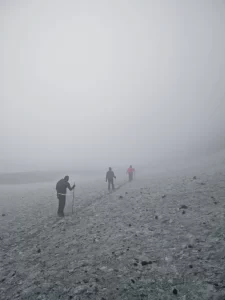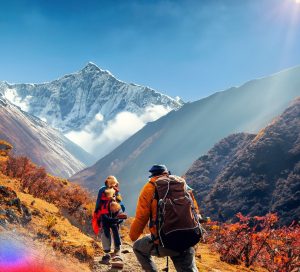Trekking is a great way to get exercise, enjoy the outdoors, and see some amazing scenery. But when is the best time to go trekking? It depends on where you want to go and what you’re looking for in a trekking experience. In this blog post, we’ll discuss the best trekking seasons for travelling in Nepal and help you find the best time to trek in Nepal for the next trek.
Understanding Nepal’s Climate and Seasons
Nepal is a great place for trekking because it has stunning natural beauty and has a lot to offer for travel and trek enthusiasts of every level. However, the best time to go trekking in Nepal depends on a few factors, such as the weather, the crowds, and the type of trek you want to do. Before planning for a trek and finding the ideal time for trekking, you must understand Nepal’s climate and seasons.
Generally, as we all know, most of the countries in the world have four seasons which are Spring, Autumn, Summer and Winter. But, in Nepal, a year is divided into six seasons which are Spring, Early Summer, Summer Monsoon, Early Autumn and Late Autumn. In Nepali language, seasons are called “Ritu”. Knowing about these ‘Ritus’ or ‘Seasons’ will help you choose the best time for your trekking adventure.
Overview of Nepali Seasons (Ritu)
- ‘Mid – March’ to ‘Mid – May’ is Spring season which is called as ‘Basanta Ritu’
- ‘Mid – May’ to ‘Mid – July’ is Early Summer which is called as ‘Grishma Ritu’
- ‘Mid – July’ to ‘Mid – September’ is Summer Monsoon which is called as ‘Barsha Ritu’
- ‘Mid – September’ to ‘Mid – November’ is Early Autumn which is called as ‘Sharad Ritu’
- ‘Mid – November’ to ‘Mid – January’ is Late Autumn which is called as ‘Hemanta Ritu’
- ‘Mid – January’ to ‘Mid – March’ is Winter which is called as ‘Shishir Ritu’
Why choose the right time for trekking?
It is crucial to plan your hike at the right time for a secure and pleasing experience. You need to consider factors like the weather, how the trails are, what the scenery is like, the cultural things you can experience, and what you personally prefer. You will have a great time, stay safe, and get the most out of your trekking expedition if you pick the right time.

What is the best time to travel and trek in Nepal?
To help you choose the perfect time for trekking, we have divided the seasons as ‘The Peak Trekking Seasons’ and ‘Off-Peak Trekking Seasons’.
The Peak Trekking Seasons:
As mentioned above the best trekking season is Autumn which makes the best time to travel and trek in Nepal is the months of September to November.
Autumn (September to November)
Autumn is practically the perfect season for hiking because of the weather which is just the best, with clear skies, temperature that is neither too high or low, and little to no rain. The wonderful snow-capped mountains as well as other vibrant sceneries are all there for you to witness. It feels so exciting. The Annapurna Circuit, Langtang Valley, and Everest Base Camp are among the popular destinations for hikes during this period. In addition, the major festivals of hindus also lie in the same period.

In this season, Nepal’s landscapes look super amazing! The skies are so clear that we can see the beautiful himalayas perfectly, making our pictures awesome. The weather is just right – not too hot or too cold – which makes trekking really fun and easy. We can explore all the wonderful nature along the trails without any problems. It is like a dream come true for trekkers.
Spring (March – May)
In Nepal, spring is the best season for hiking. You will witness a lot of lovely flowers, beautiful surroundings, and numerous animals. With moderate temperature, clear skies, and longer days, the weather is pleasant. It is ideal for hikers. One unique feature is the rhododendron forests, which blossom in vibrant colors like red, pink, and white and give the area a feeling of magic.
Spring is a beautiful time for nature lovers in Nepal. The hillsides become colorful with pretty flowers like rhododendrons, and many more. Everywhere you look, there is fresh greenery, and you can hear the lovely songs of birds. In many places of Nepal, especially in conservation areas, there are also rare animals to see, like the red panda, musk deer, and different kinds of birds. If feels like a magical and captivating.
Nepal experiences pleasant and temperate weather in the spring. The nights are cold and the days are warm. The mild weather makes it appropriate for trekking. Spring is a terrific time to travel, regardless of whether you are a seasoned hiker or just getting started. You will have an awesome time trekking because the paths are mostly dry and there isn’t much rain.
The Off-Peak Trekking Seasons
The off-peak trekking season refers to the time of the year when there are fewer tourists and trekkers visiting a particular trekking destination.
Winter (December to February)
The Himalayas in Nepal in winter are like a surreal paradise. It is extremely peaceful because the mountains are completely covered in stunning white snow and fewer people are present. Once you get in higher altitude, it can be quite cold, but if you enjoy being by yourself with nature, it is ideal. Icebergs and frozen waterfalls give the pathways a wonderful look.
Just remember to prepare will and be careful while trekking in winter, but the quiet and calmness you’ll find in these pristine places will be totally worth it.
Challenges and Precautions for Winter Trekking
Due to the extreme cold and the possibility of snowy routes, winter trekking can be challenging. To keep yourself secure, you must carry warm clothing, sleeping bags, and the necessary equipment. Being fit and cautious is especially vital when walking on snowy surfaces. To be safe, it is better to choose short trekking areas of Nepal with lower elevations and get help from experienced guides or local experts. That way, you can have a fun and safe winter trekking adventure.
Summer (June to August)
It rains a lot throughout the summer, which is also Nepal’s monsoon season, and everything turns quite green. It is not congested because there are not many people in the trekking or traveling areas. Trekking in the summer requires careful planning and preparation, but it offers the chance to find undiscovered routes and take in the stunning scenery the monsoon rains have created. It feels like a true adventure.
With the monsoon rains reviving the flora and converting the landscapes into a colorful heaven, Nepal is at its greenest in the summer. With rich vegetation, waterfalls and overflowing rivers, the hills and valleys come to life. Trekking in the summer gives you the chance to explore a more genuine and solitary side of Nepal and its hidden beauty.
Coping with Rainfall, Leeches, and Higher Altitude Risks
Monsoon season trekking demands careful consideration of the weather and associated dangers. Trails may get slippery from the heavy rain, and rivers may be difficult to cross. In some areas, leeches are common, thus adequate precautions and protection are required. The possibility of landslides and cloud cover obstructing mountain views also need to be considered.
To conclude, picking the right time to travel and trek in Nepal is super important to have a safe and fun experience. You need to know about the weather of Nepal and seasons to plan your trip well. Whether you like the busy trails in autumn, the colorful spring, the calm winter, or the exciting off-the-beaten-path treks in summer, Nepal has something for everyone. Think about what you like, the weather, how hard the trek is, and the culture you want to experience. Plan ahead, pack the right stuff, and enjoy the special things each season offers during your trekking adventure.
